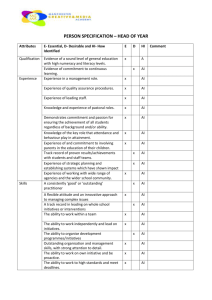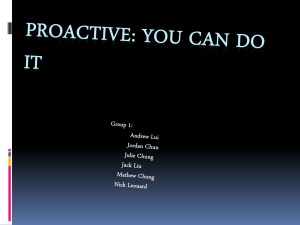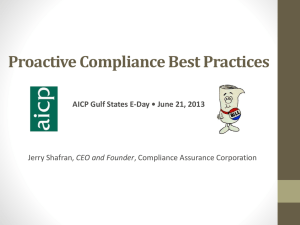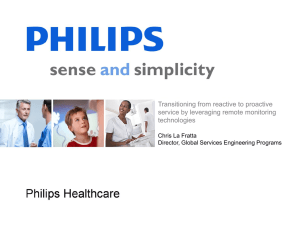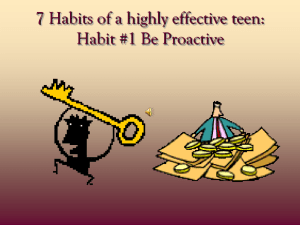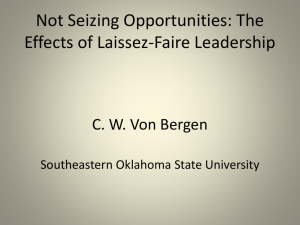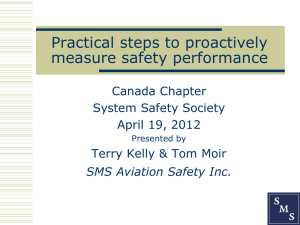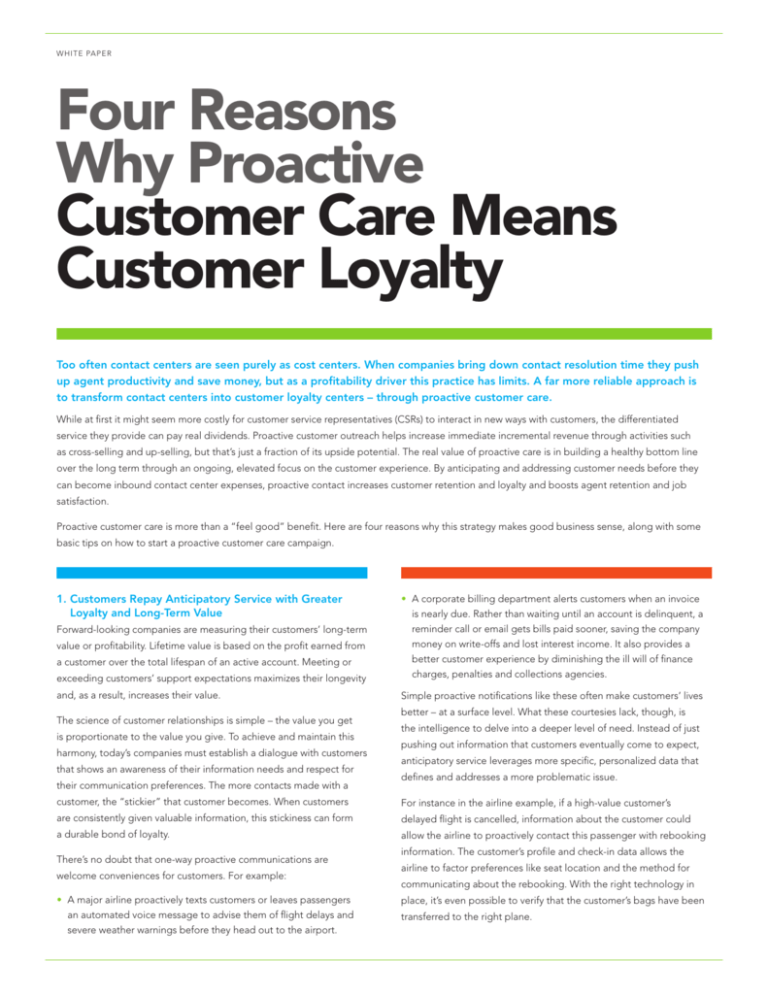
W H I TE PAPE R
Four Reasons
Why Proactive
Customer Care Means
Customer Loyalty
Too often contact centers are seen purely as cost centers. When companies bring down contact resolution time they push
up agent productivity and save money, but as a profitability driver this practice has limits. A far more reliable approach is
to transform contact centers into customer loyalty centers – through proactive customer care.
While at first it might seem more costly for customer service representatives (CSRs) to interact in new ways with customers, the differentiated
service they provide can pay real dividends. Proactive customer outreach helps increase immediate incremental revenue through activities such
as cross-selling and up-selling, but that’s just a fraction of its upside potential. The real value of proactive care is in building a healthy bottom line
over the long term through an ongoing, elevated focus on the customer experience. By anticipating and addressing customer needs before they
can become inbound contact center expenses, proactive contact increases customer retention and loyalty and boosts agent retention and job
satisfaction.
Proactive customer care is more than a “feel good” benefit. Here are four reasons why this strategy makes good business sense, along with some
basic tips on how to start a proactive customer care campaign.
1. Customers Repay Anticipatory Service with Greater
Loyalty and Long-Term Value
exceeding customers’ support expectations maximizes their longevity
• A corporate billing department alerts customers when an invoice
is nearly due. Rather than waiting until an account is delinquent, a
reminder call or email gets bills paid sooner, saving the company
money on write-offs and lost interest income. It also provides a
better customer experience by diminishing the ill will of finance
charges, penalties and collections agencies.
and, as a result, increases their value.
Simple proactive notifications like these often make customers’ lives
Forward-looking companies are measuring their customers’ long-term
value or profitability. Lifetime value is based on the profit earned from
a customer over the total lifespan of an active account. Meeting or
The science of customer relationships is simple – the value you get
is proportionate to the value you give. To achieve and maintain this
harmony, today’s companies must establish a dialogue with customers
that shows an awareness of their information needs and respect for
their communication preferences. The more contacts made with a
better – at a surface level. What these courtesies lack, though, is
the intelligence to delve into a deeper level of need. Instead of just
pushing out information that customers eventually come to expect,
anticipatory service leverages more specific, personalized data that
defines and addresses a more problematic issue.
customer, the “stickier” that customer becomes. When customers
For instance in the airline example, if a high-value customer’s
are consistently given valuable information, this stickiness can form
delayed flight is cancelled, information about the customer could
a durable bond of loyalty.
allow the airline to proactively contact this passenger with rebooking
There’s no doubt that one-way proactive communications are
welcome conveniences for customers. For example:
• A major airline proactively texts customers or leaves passengers
an automated voice message to advise them of flight delays and
severe weather warnings before they head out to the airport.
information. The customer’s profile and check-in data allows the
airline to factor preferences like seat location and the method for
communicating about the rebooking. With the right technology in
place, it’s even possible to verify that the customer’s bags have been
transferred to the right plane.
with differentiated service. If that time costs $1 million a year, it can
4. Agent Job Satisfaction and Retention Increase, and
Turnover Costs Decline
yield twice that amount in new or continued business, as well as word-
Just as customer replacement is costly, so is employee replacement.
of-mouth referrals to new customers.
The CSR’s job is traditionally marked by rapid burnout and high
It may take 30 seconds to reach out to a customer to satisfy a need
turnover. According to the international recruitment firm Spherion,
the turnover of one job costs a company an average of 1.5 times the
Produc
t Info
Flight Rebook
lized Info
Persona
employee’s annual salary when separation costs, overtime payments
to temporary workers, loss of productivity and replacement costs are
Relevant
& Timely
factored.
Consider how customer-centric companies are humanizing the
customer experience through personalized, live interactions with
proactive care agents. When they spend time providing useful
information to preempt or resolve issues, agents often have more
meaningful interactions with customers. This type of exchange is a
For today’s consumers, advance notices about payment due dates,
prescription refills and low balances, although appreciated, are
becoming fairly routine. Companies can differentiate by mining data
to identify and proactively deliver personalized information that their
customers will find uniquely relevant, timely and valuable.
2. Increased Customer Retention Costs Less than Winning
New Customers
What is the cost of adding a new customer or replacing lost business?
Consider the highly competitive telecommunications industry.
Wireless carriers calculate their gross cost per subscriber addition to
be anywhere from $275 to $425. On average, it takes 12-16 months to
win-win dialogue that provides a more satisfying work experience and
influences agents to stay in their jobs longer. The burden of costly
employee turnover becomes lighter while customer relationships
grow stronger.
The Difference is Relevant Value
Financier Warren Buffett has noted, “Price is what you pay; value is
what you get.” Unfortunately, amid the cost-cutting fervor of recent
times many companies have lost sight of delivering meaningful value.
Yet customers have shown time and time again that they are willing to
pay more for higher perceived value in any economy.
recoup that initial investment, according to the Yankee Group. As a
Unified proactive contact is about anticipating needs and intelligently
result, carriers don’t start profiting from a new customer until the last
planning outreach strategies. Proactively delivered, customer care
few months of a typical two-year contract commitment.
allows a company to provide greatly differentiated, high-touch
Here’s where proactive customer care can put a real dent in customer
churn. What if wireless carrier agents proactively engaged customers
to advise them in advance that their prepaid accounts are nearly
depleted? Or even better, to inform them about more appropriate
services that reinforce the company’s brand identity and customer
value proposition. Even if these services cost the customer more,
companies will attract a loyal following of buyers who appreciate
being consistently treated like valued customers.
calling plans based on their mobile phone usage patterns? Although
customers might switch to lower cost plans, the value of locking
customers into new two-year contracts is easy to measure.
3. Contact Center Efficiency Improves with Reduced Call
Volume and Automated Outreach
Anticipate
Customer
Need
Plan
Outreach
Strategies
Automate
Campaigns
Measure
Evaluate your current business processes for customer service
patterns. Are customers calling in for more informational type
transactions? Do they go through a workflow process such as
mortgage financing approval? Many times when customers who are
transitioning through a phased process contact a business they’re just
looking for a status update.
You can preempt these interactions and reduce inbound contact
volume by proactively reaching out to customers to report on
progress. If delays occur you can immediately make them aware,
inform them of the reason and reset their expectations. The
convenience you deliver creates a more positive customer experience
that helps build loyalty, and with fully automated transactions you can
also save costs.
How to Get Started
These tips will help you frame an effective proactive customer care
strategy:
• Leverage your customers’ buying patterns as well as trends to
uncover needs and outreach opportunities. Don’t rely on customer
surveys alone for this data; observe what customers do, which is
much more telling.
• Evaluate how your customers want to be contacted – through
email, voice or SMS – and when they’re most receptive. Use the
optimal mix of automated, self-service contact and live agent
interactions.
• Measure your proactive outreach strategies and if needed modify
them for continuous improvement.
• When data mining, target the social media activity of customers
as groups and individuals. Develop and implement a listening
strategy across all channels to spot and resolve issues before they
balloon.
• Use inbound and outbound contact blending to minimize agent
downtime, match customers with the most appropriate agents,
streamline interactions and provide consistently high-quality
customer experiences.
• Think creatively – innovate new proactive services that set you
apart from your competitors.
• Consider a unified solution that offers the breadth and depth
needed for multichannel contact.
• Develop a proactive care strategy that fits your unique business,
and pick the tools that best meet your customers’ preferences and
Summary
needs.
The goal of proactive customer care is to delight customers with
convenient, useful information at their moment of greatest need. The
• Assess your inbound calls to determine the best candidates for
applying a proactive contact strategy.
challenge is to find the perfect balance between containing costs and
• Consider the lifetime value of customers; don’t measure the value
of customer service in overhead costs alone.
Ultimately, squeezing more productivity out of CSRs by systematically
• Segment customers by long-term value and reserve the most
personal interactions for the most profitable and potentially
profitable customers.
value. If customer intimacy fades so does customer loyalty and the
delivering value through a highly differentiated customer experience.
minimizing customer interactions reaches a point of no more return
ROI calculations become less and less compelling. As the economic
climate improves and consumer spending rises, companies with the
greatest market share of customer loyalty will be best positioned for
growth and success.
Corporate Headquarters East
300 Apollo Drive
Chelmsford, MA 01824
978 250 7900 office
978 244 7410 fax
Corporate Headquarters West
2325 E. Camelback Road,
Suite 700
Phoenix, AZ 85016
602 282 1500 office
602 956 2294 fax
Europe & Africa Headquarters
2 The Square, Stockley Park
Uxbridge
Middlesex UB11 1AD
+(44) 20 8589 1000 office
+(44) 20 8589 1001 fax
About Aspect
Aspect’s fully-integrated solution unifies the three most important facets of modern contact center management: customer
interaction management, workforce optimization, and back-office. Through a full suite of cloud, hosted and hybrid
deployment options, we help the world’s most demanding contact centers seamlessly align their people, processes and
touch points to deliver remarkable customer experiences. For more information, visit www.aspect.com.
© 2014 Aspect Software, Inc. All Rights Reserved. 3845US-D 5/14
Asia Pacific & Middle East
Headquarters
8 Cross Street
# 25-01/02 PWC Building
Singapore 048424
+(65) 6590 0388 office
+(65) 6324 1003 fax

